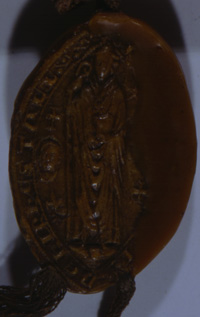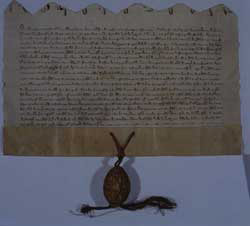 |
 |
 |
 |
 |
 |
 |
|
Changed times (3/7)
By the late thirteenth century the abbey was afflicted by financial problems attributed, in part, to ‘the ignorance and simple-mindedness’ of certain abbots, and from records of their plight we are know more about the abbey’s fortunes at this time. Kirkstall’s financial situation was so grave that the community was on the verge of disbanding and appealed to Edward I (1272-1307) for help. In 1276 the king granted them royal protection for five years and committed the abbey to the protection of their founder, Henry de Lacy, earl of Lincoln.(16) Kirkstall remained in debt to the Jews and also to a Cardinal Jordan, who may have been a papal collector. In 1279 the General Chapter ordered Abbot Gilbert de Cottles to pay up by Easter all the money owing to the reverend Father, Cardinal Jordan,(17) and when in 1280 this had not been rendered, asked for Gilbert’s resignation.(18) In 1281 the community requested permission from the General Chapter to disband for a year on account of their impoverishment; this kind of temporary dispersal was conceded to abbeys faced with such hardships.(19)
In 1284,(20) the abbey’s financial situation was critical, so much so that the community had consumed almost all its livestock. An inventory of Kirkstall’s possessions in 1284 (21) reveals that there were at this time only sixteen draught oxen, eighty-three cows, sixteen yearlings and young bullocks, and twenty-one asses; no sheep are recorded, perhaps the result of the sheep scab of 1276. The abbey’s debts amounted to £5 248 15s 7d and five sacks of wool.(22)
Comparison with other houses is revealing. Sawley, the poorest of the Yorkshire houses, had in 1381 seventy cattle, thirty milk cows, thirty-five horses;(23) in the mid-twelfth century, when Jervaulx was considered too poor to survive independently, the abbey had forty cows, with calves, three hundred sheep, five sow with litter, sixteen mares with foals, thirty hides in the tannery and forty carucates of land under cultivation. In an attempt to remedy the situation, the abbot of Kirkstall travelled to Gascony to seek the king’s aid; his lengthy letter to the community reporting on his progress is included in the Foundation History of the house.(24) This tells of the abbot’s unexpectedly long journey, during which he suffered from quartan fever; it explains that the abbot engineered a private audience with Edward I, to whom he described the abbey’s desperate situation, and successfully obtained two royal writs. Edward was moved to pity and granted the community royal protection; he promised that he would not distrain their Yorkshire manors of Collingham and Bardsey, and asked the royal treasurer, the bishop of Ely, to negotiate a reasonable payback with the monks’ creditors. The abbot enclosed copies of these writs with his letter back to the community. Whilst the king would not interfere with the repayment of the abbey’s debts to Coik (Tokys), the Jew, and Cardinal Jordan, it was agreed that Kirkstall should yield lands and rents to the value of £41 7s 9d to their patron, Henry de Lacy, in return for an annual payment of £53 5s 8d and a loan of £350 to pay off their most pressing debts to Coik and Cardinal Jordan.(25) These measures were evidently effective, for when the abbot of Fountains visited in 1301 Kirkstall was in a much healthier state. The visitation report reveals that at this time there were 216 draught oxen, 160 cows, 152 yearlings and young bullocks, 90 calves, 4500 sheep with lambs; the abbey’s debts had been reduced considerably and now totalled £160.(26) |
||||

